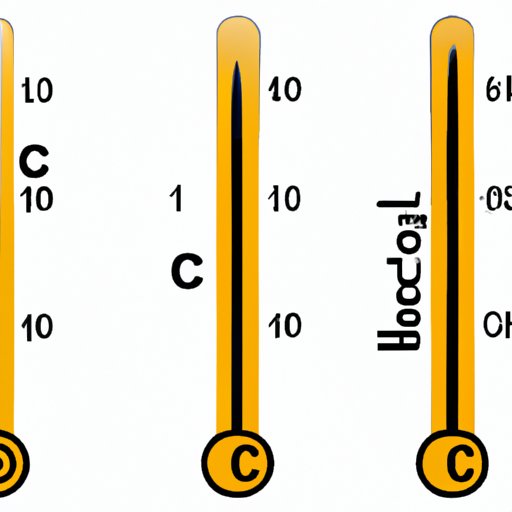
I. Introduction
Have you ever come across a temperature scale you are not familiar with? Or have to calculate the temperature in Fahrenheit but only have the Celsius measurement? Do not worry, understanding how to convert Celsius to Fahrenheit can help you make sense of any temperature scale. In this guide, we will cover everything you need to know to perform this conversion in a few simple steps.
II. The Scientific Explanation
To convert Celsius temperatures to Fahrenheit, it is essential to understand the basics of these two temperature scales.
The Celsius scale, also known as the centigrade scale, is the most commonly used temperature scale in the world. Water freezes at 0°C and boils at 100°C at standard atmospheric pressure.
The Fahrenheit scale, on the other hand, is used mainly in the United States. Its range is based on the human body temperature, with 98.6°F as the average healthy human body temperature.
The formula to convert Celsius to Fahrenheit is (Celsius temperature x 1.8) + 32.
While both scales have similar temperature ranges, the key difference is the initial measurement point. In Celsius, 0 is the freezing point, whereas in Fahrenheit, 32 is the freezing point. This means that a temperature in Fahrenheit will always be higher than its equivalent in Celsius.
III. The Practical Guide
Converting Celsius to Fahrenheit might sound tedious, but it’s pretty straightforward. Here are the steps:
- Multiply the temperature in Celsius by 1.8.
- Add 32 to the result from step one.
- The resulting answer is the temperature in Fahrenheit.
If you have trouble remembering the formula, don’t worry. You can find numerous conversion calculators and tables online or on your phone.
Let’s look at some practical scenarios you can use these formulas with:
- Cooking: Often, recipes might only give the temperature in one scale and require the other. In this case, you can use the formula to convert from Celsius to Fahrenheit or vice versa.
- Weather forecasts: Weather forecasts use different temperature scales in different countries. Understanding how to convert between Celsius and Fahrenheit will help you make sense of the weather forecast, whether it’s in Celsius or Fahrenheit.
When measuring temperature, it is essential to use the correct thermometer for the measurement you want to make. For example, a cooking thermometer will measure temperature differently from an oral thermometer used for taking human body temperature.
IV. The Interactive Approach
Using a Celsius-Fahrenheit calculator is one of the easiest ways to convert a temperature measurement. These days, numerous online tools and apps are available that can make the conversion process more straightforward and faster.
Here are some steps to use a Celsius-Fahrenheit conversion calculator:
- Enter the temperature you want to convert in the appropriate field based on the temperature scale (Celsius or Fahrenheit)
- Click ‘calculate’ or ‘convert’.
- The converted temperature will be displayed immediately.
An online conversion calculator can be helpful when you require frequent conversions and do not want to do the math every time.
V. The Historical Perspective
Both the Celsius and Fahrenheit scales were developed in the early 1700s by two scientists who used different reference points to create their temperature measurement scale.
The Celsius scale was developed by Swedish astronomer Anders Celsius initially. He chose to use 0°C as the temperature at which water freezes and 100°C as the temperature at which it boils. This scale was reversed after celsius’s death and was named after him.
The Fahrenheit scale, on the other hand, was developed by German physicist Daniel Gabriel Fahrenheit. He chose to use as his reference temperatures the lowest temperature he could create, which he determined to be -17.8°C and the temperature of a healthy human body, 98.6°F.
Today, both scales are widely used in different parts of the world, and their contribution to climate science is significant.
VI. The Infographic Approach
Infographics can be a fun and visual way to represent data and complex information like the Celsius-Fahrenheit conversion formula. Here’s an example of a Celsius-Fahrenheit conversion chart:

The infographic shows the conversion formula in a visually appealing way and can be used as a reference guide for Celsius to Fahrenheit conversions in everyday situations.
VII. Tips and Tricks
Here are a few essential tips and tricks to keep in mind when converting Celsius to Fahrenheit:
- To convert from Fahrenheit to Celsius, subtract 32 from the Fahrenheit temperature and then divide the result by 1.8.
- Always ensure that the thermometer you’re using corresponds to the system of measurement that you want to use.
- Keep in mind that when handling extreme temperatures, different materials, and altitude, conversion formulas might vary.
- Always double-check your calculations to ensure accuracy.
- Use a conversion calculator or reference chart to avoid making common mistakes.
VIII. Conclusion
Converting Celsius to Fahrenheit might sound like a chore. Still, with the appropriate tools and basic understanding of the differences and formulas involved in each scale, it can be a straightforward and quick process. Whether you’re cooking or trying to understand a weather forecast, this guide has covered everything you need to know to perform accurate temperature conversions.
Remember, always double-check your calculations and use online tools or apps to simplify the process and reduce errors. With this knowledge, you can better understand the temperature information you come across in everyday life, and you’ll find that the conversion process becomes almost automatic over time.




